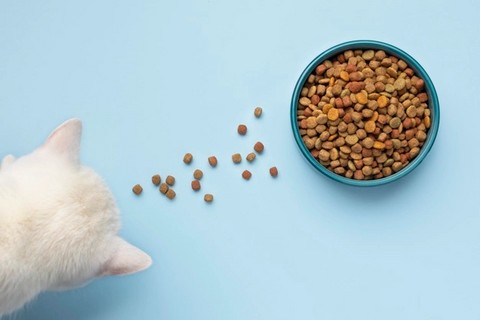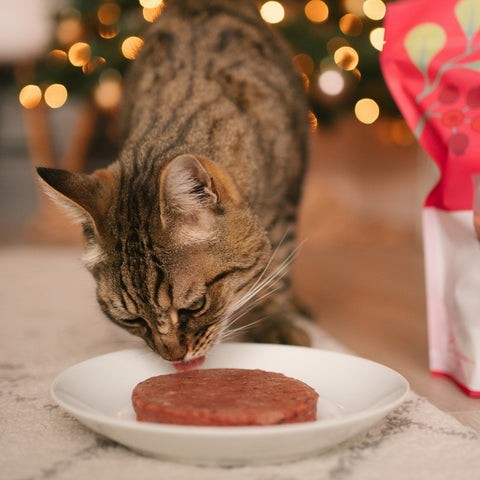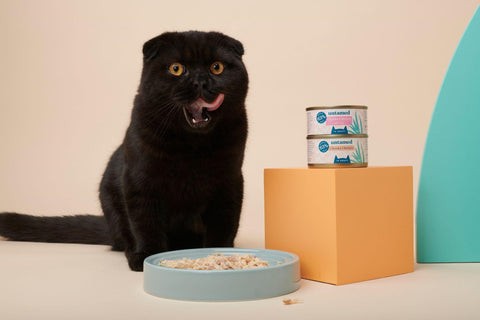What Is In Cat Food? Ensuring your feline friend receives optimal nourishment starts with understanding the ingredients in their food, because proper nutrition is key. FOODS.EDU.VN provides a deep dive into feline nutrition. Explore our detailed guide to uncover the key components and vital insights for cat food!
1. Understanding Cat Food Composition
Most commercial cat food, whether dry, wet, or semi-moist, generally contains a mix of ingredients. These often include meat (such as poultry or beef), fish, grains, vegetables, and by-products from both meat and vegetables. Additionally, cat food typically contains nutrient supplements, artificial thickeners, and flavor enhancers. But are these components truly beneficial for your cat? Let’s investigate further to ensure your cat’s diet aligns with their nutritional requirements.
Happy cat enjoy eating food
2. Essential Nutrients: What Cat Food Should Include
High-quality cat food should deliver a balanced combination of vital nutrients. These nutrients include water, fats, vitamins, minerals, and proteins, each essential for different aspects of a cat’s health and well-being. Meeting these nutritional requirements is crucial for maintaining overall feline health.
2.1. Hydration: The Importance of Water Content
The moisture content of cat food is vital because it helps maintain proper hydration in cats. Wild cats obtain most of their required hydration from their diet rather than drinking water. Ideally, cat food should have a moisture content of about 70%. Commercially available wet cat foods usually meet this standard. Cats that primarily consume dry food need additional water sources or occasional wet food supplements to prevent dehydration. Dehydration can lead to several severe health issues, including electrolyte imbalances and reduced oxygen transportation, affecting overall health.
2.2. The Role of Fats in a Cat’s Diet
Fats serve multiple critical functions in a cat’s diet. They enhance the taste of food and aid in transporting nutrients to cells. Fats also play a role in nerve signal transmission and act as a secondary energy reserve when protein levels are low. Therefore, fats should constitute up to 20% of a cat’s daily food intake, supporting their energy needs and overall health.
2.3. Vitamins: The Building Blocks of Health
Vitamins are crucial for ensuring that all metabolic processes in a cat’s body function correctly. The following table outlines the essential vitamins for cats and their specific roles in maintaining health.
| Vitamin | Role |
|---|---|
| A | Maintains healthy skin, proper vision, reproductive health, mucous membranes, and supports bone and tooth growth. |
| D | Enhances calcium and phosphorus levels, which are essential for the growth and maintenance of strong bones. |
| E | Acts as an antioxidant, protecting the body’s cells from damage. |
| K | Essential for effective blood clotting. |
| Thiamin | Plays a key role in carbohydrate metabolism. |
| Niacin, Pyridoxine, Riboflavin, and Pantothenic Acid | Facilitates the metabolism of fats, proteins, and carbohydrates. |
| Folic Acid | Participates in the synthesis of DNA and the amino acid methionine. |
| Biotin | Aids in the production of fatty acids, amino acids, and DNA/RNA. |
| Vitamin B12 | Helps in processing fats and carbohydrates and ensures proper nerve conduction. |
| Choline | Functions as a neurotransmitter, forms part of cell membranes, and transports lipids. |




Organ meats, especially the liver, are an excellent source of these vital vitamins for cats, promoting optimal health and function.
2.4. Protein: The Core of a Feline Diet
Proteins, composed of amino acids, are crucial for cats. They serve as the primary energy source, support healthy hair growth, and ensure a robust immune response. Cats require 22 amino acids, 11 of which they cannot produce themselves and must obtain from their diet. These essential amino acids include valine, lysine, taurine, leucine, arginine, threonine, histidine, tryptophan, methionine, isoleucine, and phenylalanine. Since cats cannot synthesize these amino acids adequately, consuming them through diet, especially from meat sources like taurine, is essential. Ideally, protein should constitute at least 50% of a cat’s daily food intake, emphasizing the importance of a high-protein diet.
You can incorporate the following food groups into your cat’s diet to ensure they receive adequate protein:
| Food Group | Ingredients |
|---|---|
| Meat | Chicken, Duck, Turkey, Rabbit |
| Fish | Salmon, Mackerel, Tuna, Sardine |
| Crustaceans | Shrimp, Prawns |
While lean deli meats like ham can be offered occasionally, they should be given in moderation due to their high-calorie content, which can quickly lead to weight gain. Some cat food manufacturers add plant protein to increase the overall protein content of their products. However, as obligate carnivores, cats are designed to digest animal protein efficiently. Plant protein is not as effective for cats because they cannot break it down and utilize it properly.
High-quality protein sources for cats
3. Ingredients to Avoid in Cat Food
Certain ingredients can be detrimental to a cat’s health and should be avoided. These include meat derivatives, vegetable derivatives, raw meat and bones, dairy products, grains, preservatives, artificial flavors and colors, sugar, and spices. Knowing why these ingredients are harmful can help you make better choices for your cat’s diet.
3.1. Meat Derivatives: The Hidden Dangers
Meat derivatives, often referred to as meat or animal by-products, are essentially leftovers from the human food industry. These can be inexpensive slaughterhouse scraps that allow manufacturers to produce cat food at a lower cost. These by-products can include various materials, some of which are not suitable for consumption.
Animal by-products can originate from:
- Meat considered fit for human consumption
- Fish and crustaceans deemed appropriate for human consumption
- Meat initially intended for human consumption but later withdrawn for commercial reasons
- Shellfish shells
- Catering waste from domestic sources
- Processed animal proteins (PAPs)
- Eggs, eggshells, and egg by-products
- Hides, skins, hooves, feathers, wool, horns, and hair showing no signs of infectious disease
It is often impossible to know the exact contents of these by-products, and the extensive processing they undergo can strip away most of their nutritional benefits. Additionally, these products can be loaded with chemicals during food production, posing potential health risks to your cat.
3.2. Vegetable Derivatives: Empty Calories
While some cat foods claim to be rich in protein, they often source this nutrient from plants, which is problematic because cats are not designed to digest plant-based proteins effectively. Although the food might have a high vegetable protein content, cats cannot properly break it down and absorb it, rendering it nutritionally inadequate.
Vegetable derivatives also add calories to cat food without providing substantial nutritional value. These ingredients are heavily processed and can lead to digestive issues. It’s better to focus on cat foods that prioritize animal-based proteins for optimal health.
3.3. The Risks of Raw Meat and Bones
Despite the increasing popularity of raw food diets, offering raw meat and bones to cats can be risky. While such diets might resemble what wild cats consume, raw meat and bones can harbor harmful microorganisms and cause internal organ damage. It is safer to avoid feeding your cat raw chicken or any other uncooked meat to prevent potential health issues.
Risks associated with raw food diets for cats.
3.4. Dairy: A Common Misconception
Despite the common image of cats drinking milk, dairy is generally not suitable for them. Most cats lack the necessary enzymes to digest milk properly, which can cause nausea, diarrhea, and abdominal pain. While small amounts of yogurt or cheese might be acceptable occasionally, larger quantities of dairy products can lead to digestive upsets. Therefore, it’s best to avoid giving your cat milk and other dairy products to prevent potential health issues.
3.5. Grains: Nutritionally Inadequate Fillers
Grains are often used as fillers in cat food, serving as binding agents in dry food formulations. These grains contribute to a high carbohydrate content, which is unnecessary for cats. While a small amount of dietary fiber can aid digestion, the amount in most commercial cat foods exceeds the recommended level. Grain-free cat food is generally a better option, as grains are also common allergens for cats. Consuming food with grains can lead to allergies, overeating, weight gain, and obesity, as the cat tries to compensate for the lack of essential nutrients.
3.6. Preservatives, Artificial Flavors, and Colors: Hidden Dangers
Artificial flavorings and colorings are often added to cat food to improve its taste and appearance, making it more appealing to cat parents. However, these additives often mask the nutritional deficiencies of the product. Harsh chemical preservatives, such as sulfites, can lead to thiamine (vitamin B1) deficiency, while others, such as butylated hydroxyanisole (BHA), butylated hydroxytoluene (BHT), and ethoxyquin, can cause allergies and cancer. It’s best to avoid cat foods with these artificial additives.
3.7. The Problem with Sugar
Some cat parents might believe that a small amount of sugar won’t harm their cats and might even make the food more appealing. However, manufacturers often use sugar to give their products an appealing brown color or to thicken sauces. Cats cannot taste sweetness, so adding sugar serves no purpose for them. Consuming sugar can lead to vomiting, diarrhea, abdominal pain, and other gastrointestinal issues. High sugar content can also cause weight gain, leading to diabetes and dental problems. Therefore, it’s best to avoid cat foods that contain sugar.
3.8. Spices: Generally Unsafe
Spices generally provide no benefits to cats and can even be toxic. While some spices like parsley, catnip, sage, cilantro, dandelion, thyme, dill, rosemary, and valerian root can be safe in small amounts, others are harmful.
The table below highlights which spices are safe and which are toxic to cats:
| Spices Safe in Small Amounts | Spices Toxic to Cats |
|---|---|
| Parsley, Catnip, Sage, Cilantro, Dandelion, Thyme, Dill, Rosemary, Valerian Root | Garlic powder, Chives, Scallions, Oregano, Cocoa, Tarragon, Cannabis, Bay leaf, Mint, Salt |
If your cat ingests toxic spices, it’s crucial to seek immediate veterinary care. Using special pet food spices is the safest way to enhance the flavor of your cat’s meals.
4. Decoding Cat Food Labels
Understanding cat food labels is essential for making informed decisions about your cat’s diet. The packaging can provide valuable information about the ingredients and nutritional content of the food. Learning to interpret these labels can help you choose the best food for your feline companion.
4.1. Understanding Cat Food Labels
According to the Pet Food Manufacturers Association (PFMA), cat food labels have specific meanings that can help you assess the quality of the product:
| Label | Meaning |
|---|---|
| Fresh | The ingredients used during production can only be refrigerated; no further processing or addition of preservatives to extend the product’s shelf life is allowed. |
| Natural | The use of synthetic ingredients is prohibited. The ingredients must not contain additives or undergo chemical processing. |
| Organic | Cleaning materials and pest control methods were strictly monitored and regulated; no genetically modified organisms (GMOs) or synthetic ingredients were used during production. |
| Complete | The product must contain all nutrients essential to cats in sufficient amounts. |
| Light cat food | The food contains 15% fewer calories than products in the same category. |
| Increased/Reduced | The ingredient that follows is 15% more or less present in the food than in same-category products. |
| No added/Made without | The ingredient that follows is not used as an ingredient directly or indirectly as an additive, animal feed, or similar. |
4.2. Evaluating Ingredient Lists
You don’t need to be a vet or a cat nutrition expert to understand cat food ingredient lists. A key sign of lower-quality cat food is a long ingredient list, which often indicates the presence of numerous nutritional supplements. This suggests that the food itself lacks adequate nutrition, necessitating additional supplementation to meet the cat’s dietary needs.
High-quality cat food usually has a shorter ingredient list, signaling that the main components provide sufficient nutrients. However, it’s still important to carefully read and understand each item. Manufacturers sometimes use collective terms to shorten lists, making it difficult to know precisely what’s in the food. For example, listing “meat” without specifying the source or type can hide whether the food contains whole meat, organ meat, processed meat, or by-products.
5. Untamed: High-Quality Cat Food
At FOODS.EDU.VN, we know that choosing the right cat food can be difficult. That’s why we offer only human-grade ingredients, cooked gently to retain their nutritional value. Our recipes are formulated by veterinarians to ensure they meet all of your cat’s nutritional needs.
When you choose FOODS.EDU.VN, you are opting for:
| Yes To | No To |
|---|---|
| Finest whole meat and fish | Harmful chemicals |
| Vet-formulated recipes | Meat and vegetable by-products |
| Double the amount of protein than the industry standard | Grain fillers |
| Optimal hydration | Sugar |
| Healthy and tasty cat food | Animal cruelty |
| Carbon-neutral operations and recyclable packaging. Visit us at 1946 Campus Dr, Hyde Park, NY 12538, United States or Whatsapp us at +1 845-452-9600 | Additional food preparation |
6. How to Order
Ordering from FOODS.EDU.VN is easy and convenient. Follow these simple steps to get started:
- Visit our website at FOODS.EDU.VN.
- Browse our selection of cat food.
- Place your order.
We deliver directly to your door, making it easier than ever to provide your cat with high-quality nutrition.
Happy and healthy cat.
7. Benefits of FOODS.EDU.VN
Our recipes are designed to be suitable for cats of all ages, breeds, and sizes. Even the pickiest eaters love our food.
Here’s what our customers have reported:
| Timeline | Benefits |
|---|---|
| One Month | Better digestion and less mess in the litter box |
| Two Months | More energy and improved muscle tone |
| Four Months | Shinier coat and fewer hairballs |
| Six Months | Easier weight management and better immune response |
8. Recognizing Nutritional Deficiencies
If your cat’s food is nutritionally inadequate, they may show signs of deficiency. These signs can include lethargy, poor vision, hollow claws, reduced or excessive grooming, dry skin, sudden weight loss or gain, red and swollen gums, inconsistent potty habits, irregular eating habits, and excessive shedding. Nutritional deficiencies are often seen in cats fed poorly planned homemade diets or low-quality commercial cat food.
9. Special Considerations
Be extra cautious when selecting food for cats with specific health conditions. Cats with diabetes, food allergies or intolerances, kidney problems, cystitis, or urinary tract infections (UTIs) need tailored diets and medical monitoring. FOODS.EDU.VN can help you find the right food to manage these conditions effectively.
Sensitive cats may react poorly to too many ingredients in one meal. If your cat has a sensitive stomach, consider switching to single-source protein meals.
10. FAQs About What’s in Cat Food
-
What are the main ingredients in most commercial cat foods?
Most commercial cat foods contain a mix of meat (poultry or beef), fish, grains, vegetables, and by-products from both meat and vegetables, along with nutrient supplements, artificial thickeners, and flavor enhancers.
-
Why is moisture content important in cat food?
Moisture content is vital because it helps maintain proper hydration in cats, as wild cats obtain most of their hydration from their diet. Ideally, cat food should have a moisture content of about 70%.
-
What percentage of a cat’s diet should be made up of fat?
Fats should constitute up to 20% of a cat’s daily food intake, supporting their energy needs and overall health.
-
Which vitamins are essential for cats?
Essential vitamins for cats include A, D, E, K, Thiamin, Niacin, Pyridoxine, Riboflavin, Pantothenic Acid, Folic Acid, Biotin, Vitamin B12, and Choline, each supporting various aspects of health.
-
Why is protein so important in a cat’s diet?
Proteins are crucial for cats as they serve as the primary energy source, support healthy hair growth, and ensure a robust immune response. Cats require 22 amino acids, 11 of which they must obtain from their diet.
-
What are meat derivatives, and why should they be avoided in cat food?
Meat derivatives are leftovers from the human food industry, often inexpensive slaughterhouse scraps. They can be of unknown content, heavily processed, and potentially harmful.
-
Why are grains considered a suboptimal choice for cats?
Grains are often used as fillers, contribute to high carbohydrate content, are common allergens, and can lead to overeating, weight gain, and obesity.
-
Are artificial flavors and colors safe in cat food?
Artificial flavors and colors are often added to improve taste and appearance but can mask nutritional deficiencies and may contain harmful chemical preservatives.
-
Can cats consume spices safely?
Most spices are not beneficial for cats and can even be toxic. Safe spices in small amounts include parsley and catnip, while toxic spices include garlic powder, chives, and oregano.
-
What does it mean when a cat food label says “complete”?
A “complete” label means the product contains all nutrients essential to cats in sufficient amounts.
Choosing the right cat food involves careful consideration of its ingredients and nutritional content. At FOODS.EDU.VN, we understand the challenges of finding high-quality cat food and are dedicated to providing clear, reliable information to help you make the best choice for your feline friend. For more in-depth information and expert advice on feline nutrition, visit foods.edu.vn today and explore a wealth of resources to support your cat’s health and well-being.